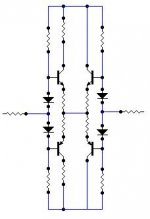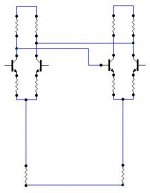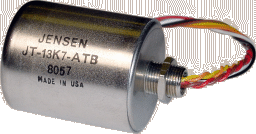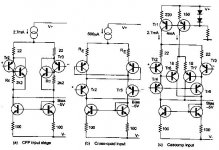Hi everyone,
Just fascinated by the various topologies used at input stages of an amplifier, such as,
1 Single Ended Differential
2 Dual Differential
3 Diamond Differential
4 Cascode loaded Differential [dual and single ofcourse]
5 Cascaded Differential
What is the best configuration for an amplifier input stage according to your experience.
So , guys lets start another thread dedicated to our differential stage topologies.
cheers,
Kanwar
😉
Just fascinated by the various topologies used at input stages of an amplifier, such as,
1 Single Ended Differential
2 Dual Differential
3 Diamond Differential
4 Cascode loaded Differential [dual and single ofcourse]
5 Cascaded Differential
What is the best configuration for an amplifier input stage according to your experience.
So , guys lets start another thread dedicated to our differential stage topologies.
cheers,
Kanwar
😉
Replace the bjt's with J-Fets in your diamond differential, get rid of the biasing diodes, and so you have my favourite.
You might cascode those to use higher than 15-20V rails though.
Cheers, Tino
BTW, something similar to your diamond differential is used in LM6172 and LT1364, afaik.
You might cascode those to use higher than 15-20V rails though.
Cheers, Tino
BTW, something similar to your diamond differential is used in LM6172 and LT1364, afaik.
What about the topology at the lower right ?
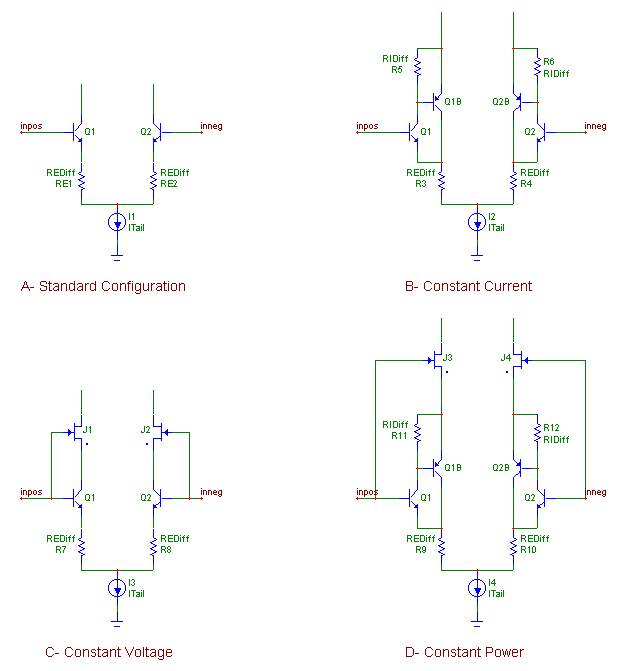
From : http://peufeu.free.fr/audio/memory/memory-4-circuits.html

From : http://peufeu.free.fr/audio/memory/memory-4-circuits.html
Just my opinion: A-Standard Configuration is "good enough" up to 150W-200W. By this I mean that the improvements afforded by other configurations are incrementally small and likely disappear under XO-distortion and the noise floor.
However, higher power amplifiers generally mean higher CL gain which could be enough to make the improvements more easily audible. It has been remarked on, and I've leard it myself, that some very high power amps have enough gain to make even thermal (Johnson) noise audible when idle.
Going back to the standard configuration -- For self constructed amplifiers, fewer components means fewer oportunitities to screw up, fewer component to fail, fewer potential bad solder joints, fewer things to investigate when the &%$$^&*=% doesn't work, fewer component pairs needeing matching. It means a smaller PCB footprint which makes it easier to do a good enclusure layout and wiring scheme. If the topology is single sided rather than mirror image, a current mirror can be added which may well provide benefits virtually equal to the more complex circuits.
If I had the time I would probably try building all the other configurations just because they look cool. I must remind myself that I should allocate some (MORE) of my time to listening to what I build rather than let it all be totally absorbed by the next great idea.
However, higher power amplifiers generally mean higher CL gain which could be enough to make the improvements more easily audible. It has been remarked on, and I've leard it myself, that some very high power amps have enough gain to make even thermal (Johnson) noise audible when idle.
Going back to the standard configuration -- For self constructed amplifiers, fewer components means fewer oportunitities to screw up, fewer component to fail, fewer potential bad solder joints, fewer things to investigate when the &%$$^&*=% doesn't work, fewer component pairs needeing matching. It means a smaller PCB footprint which makes it easier to do a good enclusure layout and wiring scheme. If the topology is single sided rather than mirror image, a current mirror can be added which may well provide benefits virtually equal to the more complex circuits.
If I had the time I would probably try building all the other configurations just because they look cool. I must remind myself that I should allocate some (MORE) of my time to listening to what I build rather than let it all be totally absorbed by the next great idea.
Workhorse said:What is the best configuration for an amplifier input stage according to your experience.
For me it's been number 6, the transformer differential. 😀
An externally hosted image should be here but it was not working when we last tested it.
se
Reminds me of the first thing I though having seen Susan Parker's amplifier - must be fun driving those input capacitances multiplied by n^2 😉
00940 said:What about the topology at the lower right ?

From : http://peufeu.free.fr/audio/memory/memory-4-circuits.html
I use a variation of "D" where the cascode FETs are replaced by simple bjts.
Oooh, goodness me, Kanwar - look what you've started!
Hi Fab. Betcha I can use more active devices than you.
Hi Fab. Betcha I can use more active devices than you.
amplifierguru said:...Hi Fab. Betcha I can use more active devices than you.
Hi amplifierguru !
Do you mean more active devices than in the face of my "AVATAR" picture ? !!! by the way this is a "borg" and not me.......
I use modified "D" but in dual diff (complementary symetric input stage) !
Hi Fab,
Just joking. "How may devices does a front end need..." ( to the tune of "Blowing in the Wind" Bob Dylan). But you forgot the IDEAL current source - surely that's good for at least 2 BJTs and a cascode.
Just joking. "How may devices does a front end need..." ( to the tune of "Blowing in the Wind" Bob Dylan). But you forgot the IDEAL current source - surely that's good for at least 2 BJTs and a cascode.
amplifierguru said:Oooh, goodness me, Kanwar - look what you've started!
Hi Mr. Greg,
I cannot able to understand what you want to say or what you meant to say or tell me. kindly use plain english so that people like us may not have to face difficulty in reading these NATIVE ACCENTED ENGLISH.
regards,
Kanwar
mastertech said:Hi workhorse kanwar
splendid thread dude
enjoy splendours from the splendid thread dude
mr l said:here's some.
good to see your diagrams.
All guys are pouring the differential designs from every corner of the world, but wait a minute could you all please tell me "Which one is the Best differential"
regards,
Kanwar
😀 😀 😉
- Status
- Not open for further replies.
- Home
- Amplifiers
- Solid State
- Best Input differential configuration in amplifiers.
